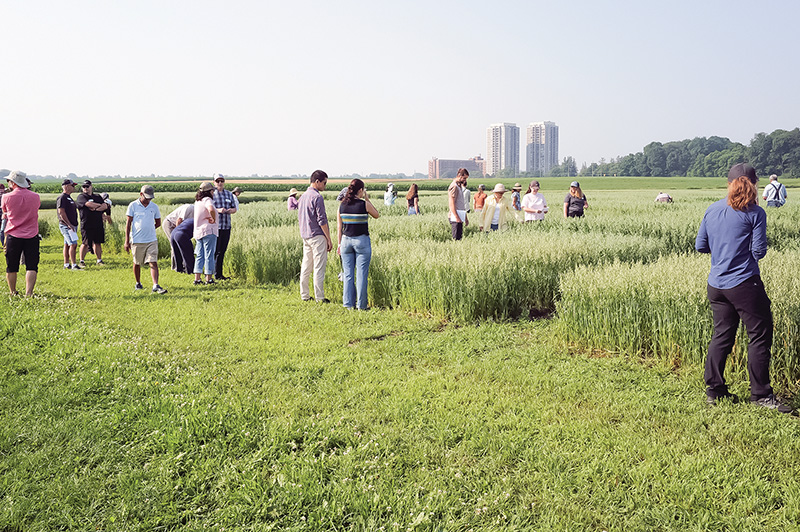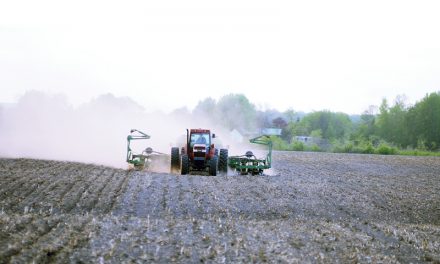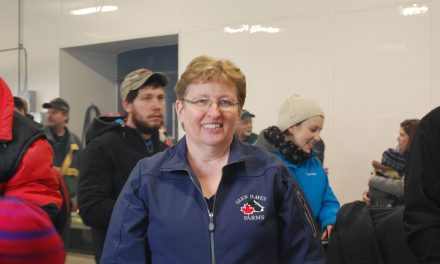Attendees were given ample opportunity to walk among the plots and examine the specimens. Tinkess Photo
OTTAWA – The Ottawa Research and Development Centre (ORDC) at the Central Experimental Farm was the site of two informative and insightful events on July 15 and 16, 2025. The events, entitled “Oat Day” and “Wheat Day” provided an opportunity to learn about the latest research and innovations, including breeding, genomics, and disease resistance, directly from experts and scientists at Agriculture and Agri-Food Canada (AAFC) and other research partners.
Oats and wheat are extremely important to Canadian agriculture, contributing significantly to the economy, food security and global trade.
The first of the two events was Oat Day, on July 15, 8:30 a.m. to 3:30pm. After meeting at the front entrance of the KW Neatby building, at 960 Carling Ave., attendees were welcomed by Jay Parsons, Director of the Ottawa Research and Development Centre (ORDC) and Dr. Weikai Yan, ORDC.
“I really want to welcome everybody for coming,” said Director Parsons. “I know we’ve got really good representation from the staff here at the centre, a lot of colleagues from NH cap, from the different branches.
“We’ve got a number of different industries, farmers, different external organizations in particular right now, we’ve also got a few colleagues from other research centres across the country as well. So, thank you for making the trip to join us today.”
The morning was then spent attending a guided tour highlighting key breeding and research plots, including yield trials and received a sneak peek of a new oat variety. Dr. Yan led the way, and speaking about each the sites and then taking questions. At the first stop, the second year of Visual Selection, Dr. Yan spoke about the process involved in developing new cultivars and provided a handout illustrating the process.
“In the handout, we have a chart in how a cultivar is developed, basically from the making of a cross to a cultivar in farmer’s field,” said Dr. Yan. “It takes about five steps. Number one, make a cross. Number two, you grow, and there are several generations until it’s pure enough to select. Number three, selection. So, this is part of the selection here. We grew about 450 lines here, but just by looking at how they look, we selected about 100 lines to go to next year’s test.”
The fourth step would be a home test, a preliminary /ENCORE, and a registration test. Step five would see the cultivar released to breeders for seed production.
Stop two on Oat Day was the seed plots (part of stage four). The lines that are tested in Preliminary and Registration tests are increased here for possible use next year. Visual observations may be used in making decisions.
Stop three is the HILL nursery. More than 10,000 are planted but less than 2000 are harvested based on height, maturity, diseases, and perceived yield potential, plus seed colour, weight and uniformity. As Dr. Yan commented, a great deal depends on appearance (“…what looks good.”)
Stop four/stage four are the yield trials. Several yield trials are planted representing the four stages of multi-location tests. Registration tests (ORDC, Quebec registration test, Western Cooperative registration test, Quaker AREA test as well as Ontario and Quebec performance trials are conducted.
Stop five/Stage five is the Breeder Seed Plot, named AAC Dwyer.
In addition to the site visits, attendees were able to discover the latest from researchers and industry partners through several presentations focusing on the performance of current oat cultivars, the oat pan genome for improving crops, gene editing in oats, oat quality testing, and other relevant topics.
The topics discussed and the presenters included the following:
- Oats in Eastern Canada from the growers’ viewpoint – Phil Bailey/Jeff Reid, SeCan
- Performance of Current Oat Cultivars in Ontario and Quebec – Dr. Weikai Yan, ORDC
- Western Oat Breeding and AAFC’s National Program – Dr. Kirby Nilsen, Brandon RDC
- The oat pan genome and global diversity. What does it mean for oat improvement? – Dr. Nick Tinker, ORDC
- Oats in the context of agrobiodiversity – Charlene Wight, ORDC
- Oat joins the CRISPR club: A breakthrough for oat breeders – Mehtab Singh (PhD student), McGill University.
- Improving drought stress tolerance in field crops through phenotyping and metagenomics – Cecily Costain (PhD student), ORDC
Day number two, July 16, was Wheat Day, and while shorter, was no less informative.
Attendees were given an inside look at cutting-edge AAFC research and innovations supporting wheat breeding and production. As with the previous day, activities started with a tour of wheat research plots and complemented the visits with talks on the latest in spring and winter wheat breeding, fusarium head blight screening and prevention, and maximizing wheat quality for different end uses.
The presentation topics and speakers were:
- Cereal phenomics, molecular plant pathology, cereal defence response – Dr. Liz Brauer, ORDC
- Spring wheat breeding and germplasm enhancement for Eastern Canada – Dr. Andrew Burt, ORDC
- Grain quality and chemistry – Dr. Mehri Hadinezhad, ORDC
- Winter wheat breeding and germplasm enhancement for Eastern Canada – Dr. Gavin Humphreys, ORDC
- Mycotoxigenic fungi research – Dr. Imane Laraba, ORDC
- Winter wheat genomics – Dr. Michel McElroy, CEROM
- Fusarium head blight screening (Field and Lab) – Christina Thomsen, Yuanhong Chen, Linda Langille (ORDC)
It is enlightening to discover the amount of research conducted while attempting to provide versions of both Oats and Wheat that are disease resistant, produce a high yield, and meet the specific requirement of the growers in the various regions across Canada, and how much of it is being conducted on what is a jewel of Canadian Agriculture, the Experimental Farm.













